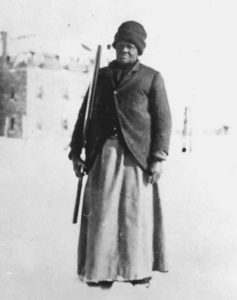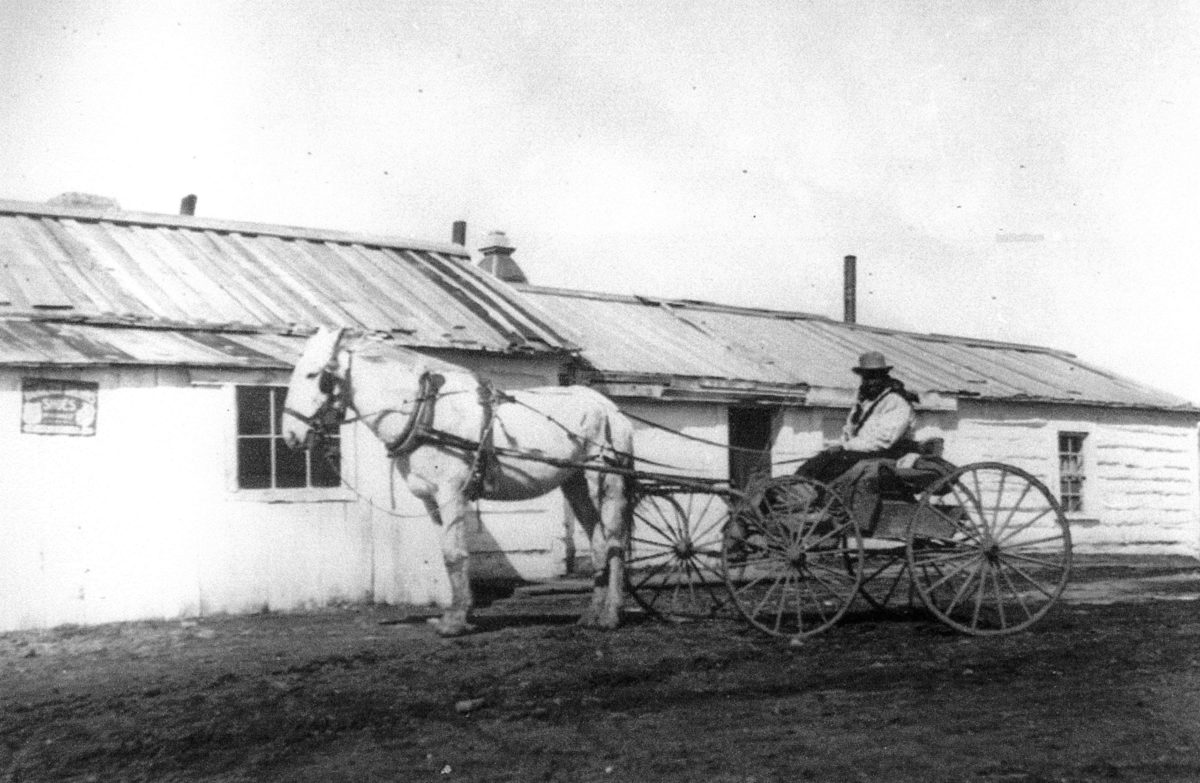
Although she may have been one of the toughest women ever to work in a convent, “Black Mary” had earned the respect and devotion of most of the residents of the pioneer community of Cascade, Montana, before she died in 1914. In fact, Mary Fields was widely beloved. She was admired and respected throughout the region for holding her own and living her own way in a world where the odds were stacked against her. In a time when African Americans and women of any race enjoyed little freedom anywhere in the world, Mary Fields enjoyed more freedom than most white men.
Fields dressed in the comfortable clothes of a man, including a wool cap and boots, and she wore a revolver strapped around her waist under her apron. At 200 pounds, she was said to be a match for any two men in Montana Territory. She had a standing bet that she could knock a man out with one punch, and she never lost a dime to anyone foolish enough to take her up on that bet. By order of the mayor, she was the only woman of reputable character in Cascade allowed to drink in the local bar, and while she enjoyed the privilege, she never drank to excess. She was often spotted smoking cigars in public, and she liked to argue politics with anyone.
Mary Fields started life as a slave in Hickman County, Tenn., in 1832. When she gained her freedom after the Civil War, she moved to Mississippi, where she worked on the steamboat Robert E. Lee as a chambermaid. She was on board during that boat’s race against Steamboat Bill’s Natchez in 1870, and she liked to relate her experience during that race when the crewmen tossed anything they could get their hands on—even barrels of resin and sides of ham and bacon—into the boiler while men sat on the relief valves to boost the steam pressure. “It was so hot up in the cabins that the passengers were forced to take to the decks,” she said, according to an article in the local Cascade Courier in 1914. “It was expected that the boilers would burst.”
Fields was the maid and childhood friend of an Ursuline sister named Mother Amadeus. When the sister served at the Ursuline convent in Toledo, Ohio, Fields joined her there. Later, Mother Amadeus was called to take a position at the new St. Peter’s Convent near what was to become Cascade, Montana, a small town that grew up on the new Montana Central railroad route between Helena and Great Falls. Mother Amadeus became ill with pneumonia in 1885 and called for Fields. Her longtime friend did not take long leaving Toledo for the West. As soon as Fields arrived at St. Peter’s Convent, she set about nursing Mother Amadeus back to health.
When Mother Amadeus was well, Fields stayed on to work at the convent. She handled the stage that brought visitors from the train station, where she would often spend the night waiting for her passengers. She also hauled critical supplies for the convent. She alone handled the wagon team that hauled the goods, no matter what the weather or road conditions. One winter night, a pack of wolves spooked her horses and the wagon overturned. Fields stood guard and protected the food shipment from the wolves through the night, knowing how much the nuns depended on the supplies to survive.
Although the sisters tried their best to smooth Fields’ rough edges by inviting her to participate in services and practice her Catholic faith, Fields preferred the rougher company of the men who worked around the convent. She drank and swore with the best of them, fought them with her formidable fists, smoked cigars, swapped stories and became a crack shot with revolver and rifle. She also worked as hard as she played. At the convent she washed clothes and sacristy linen, cared for as many as 400 chickens, and tended large gardens for the sisters.
Father Landesmith, the chaplain at nearby Fort Keough, visited St. Peter’s in 1887. He was charmed by Fields when she insisted on retelling her account of her battle with a skunk that had invaded the coop and killed more than 60 baby chicks. She dragged the dead skunk more than a mile to display her trophy to the sisters and visiting chaplain. When the sisters asked her how she avoided getting sprayed by the skunk, she explained that she was careful to make a frontal assault.
A near disaster occurred when the sisters decided to return Fields’ favors and do her chores while she was away. They did the laundry themselves without any problems, but then they decided to burn a small pile of Fields’ trash. The fire ignited some loose cartridges, and one nun, Sister Gertrude, was wounded above one eye. They were happy when Fields returned.
When the sisters moved from their log cabins to a new stone building, Fields personally moved the possessions of Mother Superior Amadeus, hauling them in a wheelbarrow. Fields continued to do her chores at the convent for 10 years, and probably would have stayed there for the rest of her life had she been allowed. But she was not. Her wild ways outside the convent finally caught up with her. After Bishop Brondell, the first Catholic bishop in Montana, received complaints about her, he told the convent that Mary Fields must leave.
One account tells of a gun duel that she had, although no details are available. Then there were the fistfights, most of which she won. During one trip to a ranch, Fields got into a heated debate over a harness. She used a small rock to emphasize her point, and ended up making a dent in the head of the ranch foreman.
Fields traveled to the state capital, Helena, to plead her case. She demanded that she be allowed to confront her accusers, but Bishop Brondell told her that nothing would change his mind. She would have to leave St. Peter’s. Unable to resist the will of her bishop, Mother Amadeus did the next best thing. She moved Fields into nearby Cascade and secured the mail route for her between Cascade and the convent. Mother Amadeus even bought her friend a wagon and a team of horses for the new route. Mary Fields became only the second woman in the country to manage a mail route. She took to her new job, sticking with it for the next eight years.
On one mail run to the convent, she was badly injured when her horse team got out of control. When she finally arrived at the convent, she was repentant for having let the horses get away from her. The sisters used the opportunity to once again encourage her to attend Mass. Some of the sisters must have been surprised when Fields agreed to come the following day. One of them stayed up most of the night to fashion a special blue challis dress and long white veil that she could wear for the special occasion.
In 1903, her longtime friend and mentor Mother Amadeus was sent to Alaska to establish another mission. Fields, now 70, was devastated. Mother Angelina, who succeeded Mother Amadeus at St. Peter’s, was kind to Fields, but it was small comfort after such a sorrowful separation.
GET HISTORY’S GREATEST TALES—RIGHT IN YOUR INBOX
Subscribe to our HistoryNet Now! newsletter for the best of the past, delivered every Monday and Thursday.
Mary Fields finally gave up her mail route and settled into town life. The people of Cascade thought so much of her that on her birthday they would close the local school in her honor. She would then buy candy and treats for the children. Not that Fields had mellowed all that much with age. She made her living by taking in laundry at her home, while continuing to frequent local drinking establishments. One day, while drinking in a local bar, she spotted a man walking by on the street. She stepped outside for a better look. Indeed, it was a man who owed her $2 for an unpaid laundry bill. She followed him down the street and grabbed the collar of the shirt she had not been paid for cleaning. Then she punched him. She returned to the bar and declared, “His laundry bill is paid.” Fields also ran an eating house that did poorly because she would extend credit to anyone who expressed a need. Sheepherders would ask her to wait for payment for meals in the winter until they were working again the following summer. She went broke twice trying to make a go of the restaurant business.
Still, she had her friends. She was always welcome in the local hotel. In 1910, when R.B. Glover leased the New Cascade Hotel from Kirk Huntley, a stipulation to the transaction was that all meals for Mary Fields would be offered free of charge for the rest of her life. When her laundry business and her home burned down in 1912, the townspeople gathered and built her a new home.
Mary Fields adopted the Cascade baseball team as her own. For each game she prepared buttonhole bouquets of flowers for each player from her own garden, with larger bouquets reserved for home-run hitters. Any man speaking ill of the local team in her presence could expect a bouquet of knuckles in his face.
Fields babysat most of the children in the area for $1.50 an hour and then spent most of the money she earned buying treats for the children. It was during this time that a small boy visiting from nearby Dearborn, Mont., noticed her. The young boy, a Montana native named Gary Cooper, would later remember her fondly in a story he wrote about her in 1959 for Ebony magazine, toward the end of his acting career and his life. Cooper died in 1961.
Charlie Russell, the cowboy artist, lived in Cascade for a brief time, and he featured Mary Fields in an 1897 pen-and-ink drawing he composed called A Quiet Day in Cascade, which shows her being knocked down by a hog and spilling a basket of chicken eggs.
Sensing that she was close to death in 1914, and not wanting to become a burden on her friends, Fields tried to steal away quietly with some blankets to die in the tall weeds near her small, two-room house. Lester Munroe and his three brothers were playing nearby, and they found Fields, who had babysat all of them, lying there in the weeds. She was taken to the Columbus Hospital in Great Falls.
When she died a few days later, there was no shortage of pallbearers for the tough but kind black woman who had befriended generations of local children. She was buried in a small cemetery alongside the road between Cascade and St. Peter’s Mission that she had traveled so many times during her life.
This article was written by George Everett and originally published in Wild West Magazine in February 1996.






